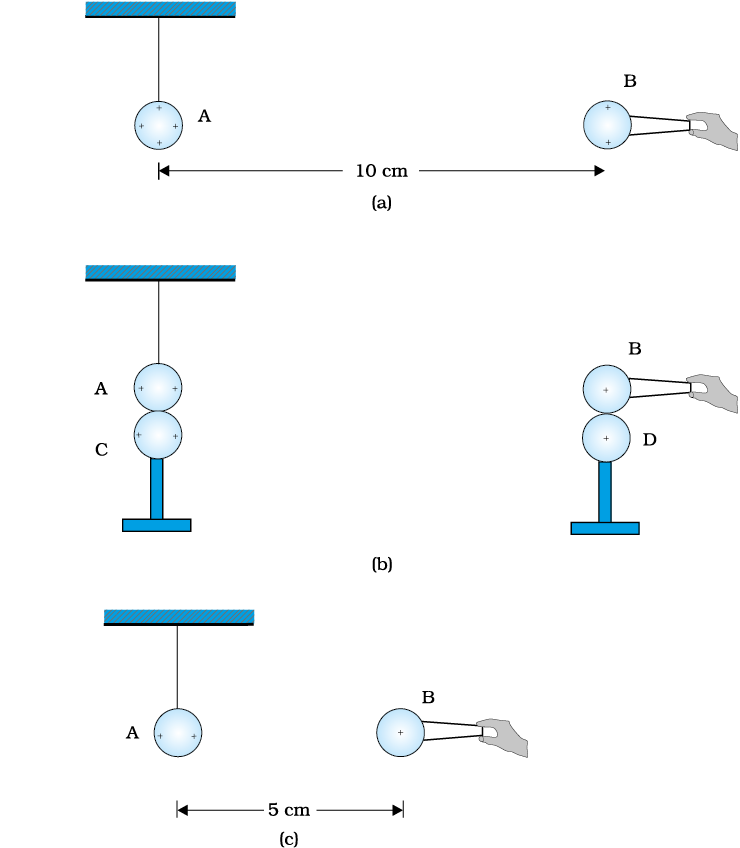The ratio of the magnitude of electric force to the magnitude of gravitational force for an electron and a proton will be:
(\(m_p=1.67\times10^{-27}~\text{kg}\), \(m_e=9.11\times10^{-31}~\text{kg}\))
1. \(2.4\times10^{39}\)
2. \(2.6\times10^{36}\)
3. \(1.4\times10^{36}\)
4. \(1.6\times10^{39}\)
A charged metallic sphere \(A\) is suspended by a nylon thread. Another identical charged metallic sphere \(B\) held by an insulating handle is brought close to \(A\) such that the distance between their centres is \(10\) cm, as shown in Fig.(a). The resulting repulsion of \(A\) is noted. Then spheres \(A\) and \(B\) are touched by identical uncharged spheres \(C\) and \(D\) respectively, as shown in Fig.(b). \(C\) and \(D\) are then removed and \(B\) is brought closer to \(A\) to a distance of \(5.0\) cm between their centres, as shown in Fig. (c). What is the expected repulsion on \(A\) on the basis of Coulomb’s law?

| 1. | Electrostatic force on \(A\) due to \(B\) remains unaltered. |
| 2. | Electrostatic force on \(A\) due to \(B\) becomes double. |
| 3. | Electrostatic force on \(A\) due to \(B\) becomes half. |
| 4. | Can't say. |
Consider three charges \(q_1,~q_2,~q_3\) each equal to \(q\) at the vertices of an equilateral triangle of side \(l.\) What is the force on a charge \(Q\) (with the same sign as \(q\)) placed at the centroid of the triangle, as shown in the figure?
1. \(\dfrac{3}{4\pi \epsilon _{0}} \dfrac{Qq}{l^2}\)
2. \(\dfrac{9}{4\pi \epsilon _{0}} \dfrac{Qq}{l^2}\)
3. zero
4. \(\dfrac{6}{4\pi \epsilon _{0}} \dfrac{Qq}{l^2}\)
Consider the charges \(q,~q,\) and \(-q\) placed at the vertices of an equilateral triangle, as shown in the figure. Then the sum of the forces on the three charges is:
1. \(\frac{1}{4\pi \epsilon _{0}}\frac{q^{2}}{l^{2}}\)
2. zero
3. \(\frac{2}{4\pi \epsilon _{0}}\frac{q^{2}}{l^{2}}\)
4. \(\frac{3}{4\pi \epsilon _{0}}\frac{q^{2}}{l^{2}}\)
The accelerations of electron and proton due to the electrical force of their mutual attraction when they are 1 Å (=) apart are respectively: (\(m_p=1.67\times10^{-27}~\text{kg},~m_e=9.11\times10^{-31}~\text{kg}\))
| 1. | \(2.5\times10^{22}\) m/s2, \(2.5\times10^{22}\) m/s2 |
| 2. | \(2.5\times10^{22}\) m/s2, \(1.4\times10^{19}\) m/s2 |
| 3. | \(1.4\times10^{19}\) m/s2, \(2.5\times10^{22}\) m/s2 |
| 4. | \(1.4\times10^{19}\) m/s2, \(1.4\times10^{19}\) m/s2 |




